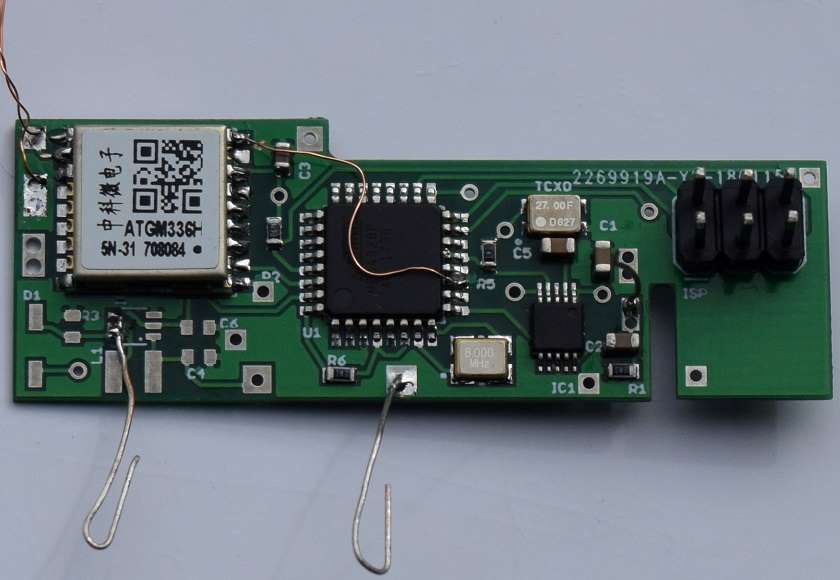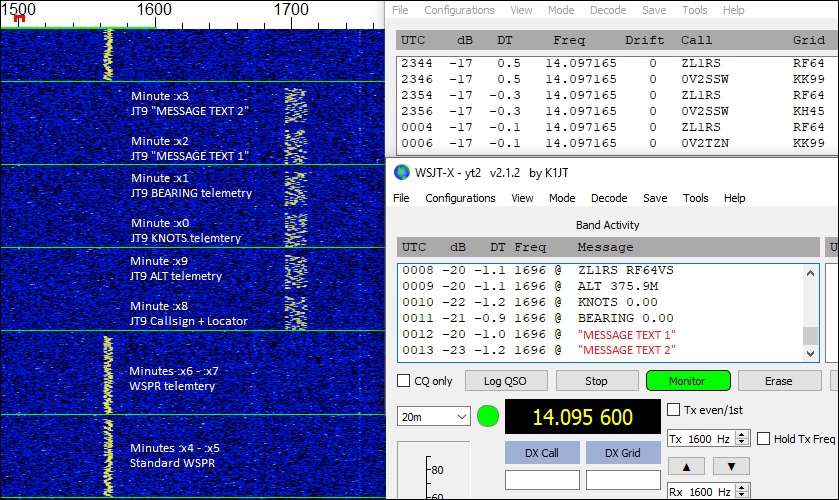High Altitude Balloon Flights Carrying HF Radio Telemetry
A miniature HF telemetry transmitter flying under a 'super pressure' party balloon.
After tracking recent Picospace balloon flights I got 'the bug' to fly some more of my own balloons. This time the aim is to reduce payload weight to gain extra altitude while still flying under a 36" diameter party balloon at a minimal cost. The following flights use lightweight 'tracker/telemetry' transmitters built following the concept of the QRP-Labs U3S transmitter, and running a special 'balloon version' of QRP-Labs U3S firmware.
Link to past flights BB01 to BB05 Link to flight BB06
Link to flight BB06 Link to flight BB07
Link to flight BB07 Link to flight BB08
Link to flight BB08 Link to flight BB10
Link to flight BB10

Balloon flight BB09 - launched on 26 April 2020 at 21:30 UTC
27 April 21:00 UTC ... nothing seen from BB09 this morning despite plenty of sun angle at the likely location, so it is assumed to have gone down with a ruptured balloon. I'll move on and finish building BB10.
27 April 04:00 UTC ... the sun angle on the solar cells became too low in the late afternoon (<18 degrees), and the transmitter stopped sending. The last altitude from the JT9 transmissions was just under 3000m. The air is still quite cold at that altitude so the ice load (if that was the case) would not have melted or slid off. We have to wait until 'tomorrow morning' to see if BB09 has recovered. The sun angle should be sufficient to start the transmitter at about 20:30 UTC, and I'll put an update here at around 21 UTC.
27 April 01:00 UTC ... the altitude reached around 9170m, then began to drop. I suspect another burst balloon, but some optimists are thinking it is ice loading which may be released in the warmer temperatures at low altitude ... and the balloon may recover.
26 April 21:30 UTC ... BB09 is almost identical to BB08, but this time it is flying under a 'Chinese clear' balloon.
Tracking on Habhub (Battery and Temperature sensors are not fitted, so ignore those readings. Altitude is in 20m increments) (Battery and Temperature sensors are not fitted, so ignore those readings. Altitude is in 20m increments)
Tracking on APRS

BB09 over-view:
Balloon: a 90cm dia 'Chinese clear' balloon with hydrogen gas providing close to 3 grams of free lift over the total payload weight
Payload: a QRP-Labs U3S based transmitter sending WSPR mode tracking and JT9 mode information at 20mW on the 20m band
Transmitter: assembled on a 'full' PC board (see pic below). It is 'flying naked' (there is no insulation or other coating on the PCB)
Antenna: a halfwave dipole (0.1mm dia wire) supported on 4 pound fishing braid with the transmitter suspended at the feed point
GPS: the GPS reset system is the same as on BB08
GPS antenna: a 1575 MHz dipole made from 0.15mm diameter enamelled copper wire
Solar cells: six 39mm x 19mm 0.5V 0.12W solar cells. The 0.5V rated cells actually produce 0.6V each in bright sun, so 3.6V in total
Voltage regulator: none
Total payload weight: transmitter + solar cells (4.8 grams) + antenna (0.9 grams) = 5.7 grams
Balloon neck lift: 8.6 grams (therefore the free lift = 2.9 grams)
Anticipated 'float altitude': 10,500m (subject to external conditions like temperature and air pressure)
BB09 transmitter compliment:
Processor: ATmega328P-AU
Processor clock: 8MHz
Synthesiser: Si5351a
Synth reference: 27MHz TCXO
GPS: ATGM336H with an experimental reset system (see BB08 for details)
Transmitter frequency:
The WSPR and JT9 signals can be received with a SSB receiver in USB mode tuned to the standard 20m band WSPR 'dial frequency' of 14.095600 MHz. The WSPR signal appears on the waterfall in the upper half of the WSPR band slot at about 1566Hz, and the JT9 appears at about 1700Hz (see the screen shot in the pictures below). The JT9 messages and GPS reset timing have been rearranged to fill up the 10 minute transmission 'frame' and to add two more plain text JT9 messages for extra interest.
Transmitter schedule:
Minute Transmission Transmission
:x4 Standard WSPR mode ... callsign ZL1RS, locator as determined by the GPS, power 13dBm / 20mW / 0.02W Standard WSPR mode ... callsign ZL1RS, locator as determined by the GPS, power 13dBm / 20mW / 0.02W
:x6 Special WSPR mode balloon telemetry (channel 02) Special WSPR mode balloon telemetry (channel 02)
:x8 JT9 using message 00 with QRP-Labs U3S tags #CS and #M6 - ZL1RS + the current 6 character Maidenhead locator JT9 using message 00 with QRP-Labs U3S tags #CS and #M6 - ZL1RS + the current 6 character Maidenhead locator
:x9 JT9 using message 01 with plain text and QRP-Labs U3S tag #AT - ALT #ATM - (altitude in meters) JT9 using message 01 with plain text and QRP-Labs U3S tag #AT - ALT #ATM - (altitude in meters)
:x0 JT9 using message 02 with plain text and QRP-Labs U3S tag #GS - KNOTS #GS - (speed in knots) JT9 using message 02 with plain text and QRP-Labs U3S tag #GS - KNOTS #GS - (speed in knots)
:x1 JT9 using message 03 with plain text and QRP-Labs U3S tag #GC - BEARING #GC - (course in degrees true) JT9 using message 03 with plain text and QRP-Labs U3S tag #GC - BEARING #GC - (course in degrees true)
:x2 JT9 plain text using message 04 - plain text message 1 (decode it if you can!) JT9 plain text using message 04 - plain text message 1 (decode it if you can!)
:x2 + 52s CW using message 05 - the letter "E" in Morse Code (see BB08 for the experimental GPS reset information) CW using message 05 - the letter "E" in Morse Code (see BB08 for the experimental GPS reset information)
:x3 JT9 plain text using message 06 - plain text message 2 (decode it if you can!) JT9 plain text using message 06 - plain text message 2 (decode it if you can!)
#AT, #GS and #GC are from the GPS output strings.
Decoding and tracking:
The WSPR telemetry capture, decoding and forwarding is done by a version of Aaron M7REG's python script (forked from SM3ULC) with further modifications by Andy VK3YT and myself. Thanks also to Jim N2NXZ for the set-up tips that saved a lot of potential grief.

The full PCB during testing. The programming header to the right hand side is cut off before the flight

A screen shot of the waterfall showing the WSPR and JT9 trails with their the associated decodes
The morse code letter E sent between minute :x2 and :x3 during the reset action is too short to be seen on the WSJT-X waterfall

One more BBxx series balloon flight is coming soon ...
|

